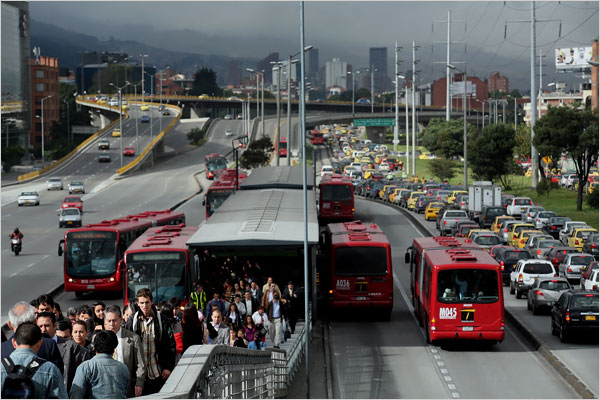While planners and urbanists often look towards Western Europe for inspiration on transportation, there are many lessons to be learned from an unsuspecting champion of the bus: Latin America.
Stretching from Mexico to Argentina, Latin America is wide, vast and diverse, but on the whole it is urbanized at a similar rate to North America, and the cities bear some of the same car-centric industrial scars that we do in North America. Because of this, urbanists in the United States often assume that American problems with car-centrism are unique, despite the many similarities to our neighbors in the South. Obviously North American cities developed differently than Latin American ones, and mass suburbanization often never was realized in Latin America. However, within urban areas, the urban form can often take the same shape, with large highway-like thoroughfares acting as arterials all across the city, cutting up neighborhoods and decreasing walkability.
The Case Study here is Cali, Colombia, a city with a somewhat North American urban form, gridded and criss-crossed by major arterials. Through looking at the three modes of public transportation in Cali we can learn about the options that are possible for our own cities, and renew hope for the future of public transit.
MÍO is the bus provider in the city, offering three basic services:
Buses: Normal, in traffic buses.
BRT: Bus Rapid Transit, a Colombian invention that has taken the transit world by storm
Cable Car: Imagine ski lifts, but public transit.
I’m going to focus on the BRT and the Cable Car, because these are the Colombian mainstays of transportation.
BRT: If you haven’t heard of Bus Rapid Transit, you might be wondering how it is different from normal buses. While we hear a lot about BRT in transportation spaces in the United States, it is often not recognized as a Latin American invention. You might be wondering how these are different from normal buses. Well, in 2000 in Bogotá, a group of transportation geniuses who didn’t have the money for a metro system decided to build a full metro system, but with buses instead of trains. They raised the platforms and transformed the interior of the buses to look more like subway cars. You have to use a keycard to tap into stations, like a metro system, and there are different platforms for outbound and inbound. The only difference, a bus on a private road instead of a metro on private tracks. Check out pictures of Bogotá’s TransMilenio system here.
In Cali, the system isn’t as robust and the stations are a bit less magnificent, but the whole system operates on separated roads with metro-style stations. I ride the buses all the time, it is crazy how much more comfortable a bus can be when it isn’t in traffic, isn’t bumpy and isn’t stopping all the time. Here’s an article with some pictures of Universidades, my home station! I love this station with all of my heart, I never wait more than 4 minutes for a bus. Living with good public transportation changes the way that you are able to live, truly! It is a component of urban freedom, especially in a city where the traffic can be horrible. The bus ride to downtown takes around 40 minutesbut once in the center there is a Chicago-style loop so you can transfer easily to other lines and head off in other directions.
Cable Car: Imagine walking down the street and seeing a fully enclosed cable car soaring over you; sounds pretty futuristic right? We would expect this kind of innovation out of cities in Europe usually, but what if I told you that this solution was born in Medellin, Colombia. The smash-hit Medellin MetroCable system reinvested money after Pablo Escobar’s death into a system of escalators, staircases and cable cars to integrate the city’s hilliest and poorest neighborhoods and make movement between these isolated neighborhoods easier. The idea was that in the wake of the drug wars and decade of violence, the city was split into isolated pockets. With transportation, the elected officials figured they could tie the city together again.The system is a marvel of engineering and heralded as a public transportation miracle, using transit as a tool to change the fabric of a city and lift an entire region out of violence and poverty. Read more about it here!
Cali only has one cable car line right now, with 4 stations, but they are amazing! Same principle, giving access to people who were previously excluded from the city. Plus the views on a cable car commute are pretty awesome too! Pictures here!
In conclusion, Colombia has used buses and ski lifts in unconventional ways to uniquely address the needs of their communities. That all begs the question, what would these things look like in Worcester? What solutions (big or small) could transform our system in profound ways.
